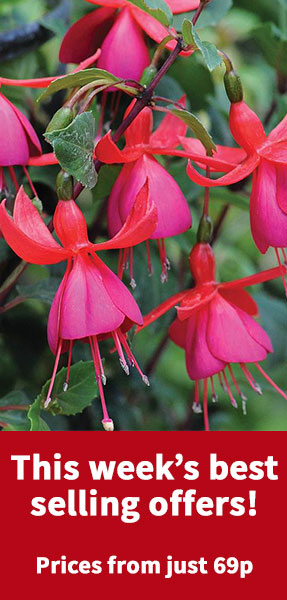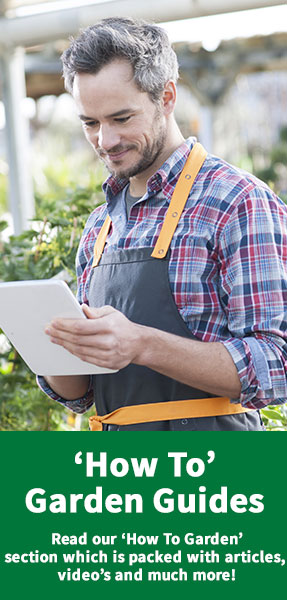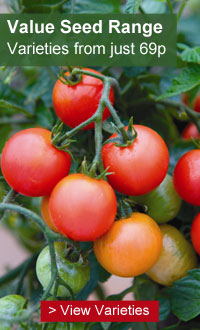
Glossary of Gardening Terms
Glossary of Gardening Terms
Annual
A plant that completes its entire life cycle (growth, reproduction, death) in one season.
Bareroot
These plants have been field-grown and are supplied in a dormant state with the soil removed. E.g Roses
Biennial
A plant that completes its entire life cycle in two years, growing in the first year and reproducing and dying in the second.
Bolting
To flower and produce seed prematurely.
Bud union
Refers to the point at which the plant has been grafted on to a rootstock and is usually found at soil level. This is the result of a technique called ‘budding’ where the bud of one plant is grafted on to another plant.
Bulb
An underground storage organ with fleshy scale leaves from which the plant flowers and grows before becoming dormant. E.g Daffodils.
Cane
The stems of a raspberry or blackberry plant. Raspberry plants are supplied as dormant canes.
Chitting
Placing seed potatoes in a tray or egg box in a bright, cool but frost-free place to encourage them to sprout prior to planting.
Cloche
Structure made of glass, plastic or horticultural fleece placed over a plant for protection or for forcing early crops.
Cold Frame
Unheated frame for growing on and acclimatising hardy and half-hardy plants outdoors.
Cordon
A plant carefully trained to grow as one main stem, or occasionally two or three main stems, by removing side-shoots. E.g tomato plants.
Corm
A rounded underground storage organ, consisting of the stem base, and often with a fibrous outer layer. It is replaced by the plant annually. E.g Begonias.
Crown
The growing point of a plant from which new shoots emerge, at or just below the soil surface. E.g Asparagus
Cultivar
A plant that is bred or selected by growers for unique flowers, leaf colour, growing habit etc. It has distinct and uniform characteristics that differ from the original species.
Dead-head
To remove the spent blooms on a plant to encourage further flowering or to prevent self-seeding.
Deciduous
A plant that sheds its leaves each year.
Direct Sow
To sow seeds outdoors in their final positions, where you would like them to flower or crop.
Earth up
To draw soil up around a plant to exclude light, protect from frost or encourage roots to develop from the stem. This is commonly done with potato crops.
Ericaceous
Used to describe plants that like acid soil and will not tolerate alkaline soils (containing lime or chalk). E.g Blueberries.
Everbearing
Refers to strawberry varieties that yield a small crop in early summer, a few berries throughout the rest of the summer, and another heavier crop during late summer and early autumn.
F1 Hybrid
First generation offspring derived from breeding two distinct pure-bred lines. They are vigorous and uniform plants. Seeds produced from F1 Hybrids will not come true to their parents.
Feathered Maiden
A one-year old tree with several side branches (feathers).
First Early Potatoes
These are harvested 10 weeks after planting and will produce new or baby potatoes.
Floricane
Refers to raspberry and blackberry stems that grow for one year before bearing fruit and flowers e.g. summer-fruiting raspberries and blackberries.
Germination
Refers to the point at which a seed undergoes physical changes and begins to grow.
Grafting
Where one plant is artificially joined to the rootstock of another so they eventually function as one plant.
Half-hardy annual
A plant that completes its entire life cycle (growth, reproduction, death) in one season. Can be grown outdoors but requires winter protection from frosts and temperatures below 0C.
Half hardy biennial
A plant that completes its entire life cycle in two years, growing in the first year and reproducing and dying in the second. Can be grown outdoors but requires winter protection from frosts and temperatures below 0C.
Half-hardy bulb/ corm/ rhizome/ tuber
Plant that grows from an underground storage organ. Generally supplied in a dormant condition with no top growth. Can be grown outdoors but requires winter protection from frosts and temperatures below 0C.
Half-hardy perennial
A plant that lives for more than two years. Can be grown outdoors but requires winter protection from frosts and temperatures below 0C.
Half-hardy tree/ shrub
Woody plant, usually having a permanent framework of branches. Can be grown outdoors but requires winter protection from frosts and temperatures below 0C.
Harden off
To acclimatise young plants that are growing in a protective environment, to cooler conditions outdoors. This is normally achieved by leaving plants outside during the day and bringing them undercover at night.
Hardy annual
A plant that completes its entire life cycle (growth, reproduction, death) in one season. Capable of withstanding outdoor winter temperatures down to -15C.
Hardy biennial
A plant that completes its entire life cycle in two years, growing in the first year and reproducing and dying in the second. Capable of withstanding outdoor winter temperatures down to -15C.
Hardy bulb/ corm/ rhizome/ tuber
Plant that grows from an underground storage organ. Generally supplied in a dormant condition with no top growth. Capable of withstanding outdoor winter temperatures down to -15C.
Hardy perennial
A plant that lives for more than two years. Capable of withstanding outdoor winter temperatures down to -15C.
Hardy tree/ shrub
Woody plant, usually having a permanent framework of branches. Capable of withstanding outdoor winter temperatures down to -15C.
Haulm
Another name for the leaves and stems of a potato plant.
Herbaceous plant
A non-woody perennial plant, often dying back in the winter and becoming dormant by means of underground rootstocks or a woody base. Growth resumes in the spring.
Lime
Calcium compounds, often applied to lower the pH of the soil (make it more alkaline); particularly useful when growing brassicas (cabbages, broccoli etc) to prevent club root disease.
Long canes
These are raspberry canes which are supplied at a more mature stage of their life and will produce fruit in their first season. The canes supplied are longer than usual (1.25-1.4m).
Maiden tree
A young tree, generally less than a year old, that can be trained into any form required.
Maincrop potatoes
These are harvested up to 20 weeks after planting and are good for winter storage. They are good for baking, roasting and mashing.
Mulch
Layer of material placed on the soil and around plants to retain moisture, suppress weeds and improve soil structure. Materials used for mulching include well-rotted manure, compost, polythene sheets or gravel.
Organic matter
Substance of animal or plant origin – such as compost, leaf mould or manure. Useful for improving soil structure and supplying nutrients to plants.
Perennial
A plant that lives for more than two years.
Pinching out
Removing the growing points of a young plant to encourage side-shoots to form. This encourages a bushy habit and more flowering stems. To find out more about 'pinching out' view our easy to follow video guide by clicking here.
Pollination
The transfer of pollen between flowers, which can be carried out by the wind, insects, animals or by hand.
Pot on
To remove a plant from its container (normally when it has outgrown the space) and place it into a new container for further growth.
Pot up
To place seedlings and cuttings into containers to grow on.
Prick out
To remove and transfer seedlings into pots or module trays to give them more space to grow.
Primocane variety
Refers to the first-year stems of raspberries and blackberries. Autumn-fruiting raspberries will produce flowers and fruit on primocanes (they produce fruit in their first year of growth).
Propagate
To grow plants from seed or by vegetative means e.g. cuttings or grafting.
Rhizome
A horizontal fleshy stem which grows at or below ground level. Rhizomes produce roots and shoots.
Rootstock
The underground part of a plant containing the roots. In grafting, a plant (scion) is joined to a desirable rootstock – often to promote a dwarfing habit.
Rose End
The end of a seed potato with the most eyes – often the widest end. Potatoes should be chitted with the rose end facing upwards.
Runner
A trailing stem growing above ground and rooting at the nodes, where plantlets are produced (e.g. strawberries). Some plants produce underground runners.
Second cropping potatoes
These are planted in late summer/early autumn and harvested about 14 weeks after planting, as for second earlies.
Second early potatoes
These are harvested about 14 weeks after planting. They make excellent salad potatoes and many varieties are also good for chips, roasting and mashing.
Seed Potatoes
A potato tuber grown specifically for starting new plants and producing potatoes.
Self-fertile
A plant that does not need pollen from a second individual in order to fertilise and set fruit.
Semi-evergreen
A plant that retains most or some of its foliage throughout the year.
Slips
Cuttings taken from a mature Sweet Potato plant.
Specimen Plant
Normally a tree or shrub grown in a prominent position where it can be viewed from different angles.
Standard
A tree or shrub that has been trained to a certain height with a long bare stem and foliage at the top.
Tender annual
A plant that completes its entire life cycle (growth, reproduction, death) in one season. Susceptible to damage or death at temperatures below 5C.
Tender biennial
A plant that completes its entire life cycle in two years, growing in the first year and reproducing and dying in the second. Susceptible to damage or death at temperatures below 5C.
Tender bulb/ corm/ rhizome/ tuber
Plant that grows from an underground storage organ. Generally supplied in a dormant condition with no top growth. Susceptible to damage or death at temperatures below 5C.
Tender perennial
A plant that lives for more than two years. Susceptible to damage or death at temperatures below 5C.
Tender tree/ shrub
Woody plant, usually having a permanent framework of branches. Susceptible to damage or death at temperatures below 5C.
Thin
To remove a number of buds, flowers, seedlings or shoots to improve the growth and quality of those remaining.
Tree/ shrub
Woody plant, usually having a permanent framework of branches.
Tuber
Swollen root or underground stem with storage tissue (e.g. a potato)
Sign Up For Exclusive Special Offers




© 2025 Thompson & Morgan. All rights reserved. A division of Branded Garden Products Limited.









